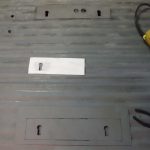Passenger Seat Partition Fabrication pt2
The fabrication of the walkthrough partition continued with the addition of ribs to the sheet metal installed yesterday. The ribs add strength to the otherwise flat sheet metal, preventing the panel from resonating while the bus is running. These ribs would have originally been pressed into the panel by a machine twice the size of the garage the bus is being restored in. Since I don’t have one of those, the ribs are being recreated by welding in a section of sheet metal bent into a “C” shape.
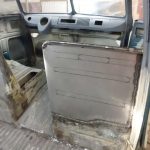
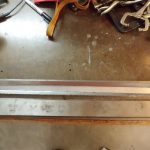




Passenger Seat Partition Fabrication
The passenger side partition panel had been cut out of the bus at some point in the bus’s past, presumably to allow the use of a swiveling seat. Although the restoration will not be 100% accurate, (i.e. non-original safari windows added) having a large part of the interior missing would have been too much of a deviation from original. So in what is probably the most ambitious fabrication project within the bus project so far, a new partition is being created. Luckily, the passenger side partition is somewhat simpler than the driver’s side partition since there are no compound curves required. First a section of tube was heated red hot and bent to the correct radius and welded in place, using a piece of angle iron clamped across the top of both partitions to keep the top tubes co-linear. Next the sheet metal was cut and bent to fit into shape. Finally the sheet metal was welded onto the top of the seat pedestal. The partition will have the raised sections added in the next few days to mirror the raised sections on the driver side partition.

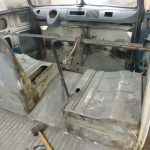
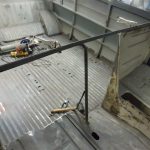
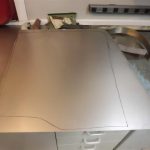




Battery Tray Repair
The battery tray had a rust hole in roughly the shape of the bottom of a battery. Years of battery leaks caused this area to rust at a faster rate than the rest of the bus. The repair is mostly complete, all that remains is to finish grinding and shape the repair to more closely match the crease lines of the surrounding metal. The repair required working in an extremely confined location hence this is probably one of the ugliest repairs I’ve done lately; it won’t be noticeable after the body work is completed.


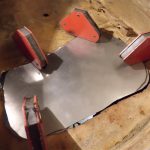

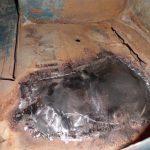
Bumper Repair
Work started on getting the bumpers ready for primer/bodywork. The front bumper only had a few minor bumps that were straightened out; the rear bumper however had a very deep dent and a tear near one of the brackets. The bumper metal is much thicker than anything else on the bus so removing the rear bumper dent required a considerable amount of beating with an 8lb hammer. Despite the crude method the dent mostly disappeared without introducing much warpage. After the bumpers were straightened paint stripping began, these are among the last remaining parts that are rust-covered. Stripping the inside of the bumpers will require media blasting that will be completed this weekend.

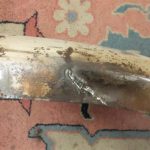
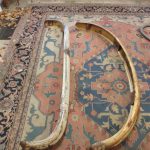

Quarter Panel Repair
The forward cargo door was hung in the door opening and many tweaks were made to achieve a consistent panel gap around all three sides. Previously the rusty/warped bottom of the cargo doors caught against the floor, causing the bottom of the doors to bow outwards. Also, the quarter panel patch was fitted, welded, and ground. The quarter panel still needs to be plug welded to the flanges that intersect it from behind; once this is completed the repair will be 100% complete.




More Cargo Door Repair
The repair on the forward cargo door was finished and the same repairs were made on the rear cargo door. The latch plate on the cargo area floor repair section had never lined up with the holes in the rocker panel, the holes in the doors, or the holes above the doors. Luckily all the holes lined up except for the latch plate, so the latch plate was moved to match the rest.


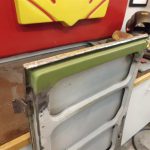
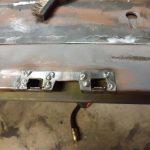
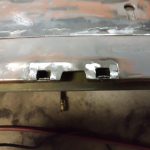
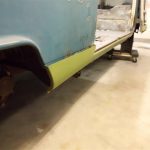
Cargo Door Repair
The lower exterior of the forward cargo door was patched. This area had many pinholes along the line where the interior frame joined the door skin and water collected. Welding together the good metal on either side of the pinholes was time consuming but still faster & neater than replacing the lower door skin.


Passenger Lower Quarter Panel Removed
The passenger lower quarter panel was heavily pin-holed with rust and although I had previously attempted repairs here it was in need of replacement. This is another scenario where the replacement part is readily available in a high-quality reproduction at a reasonable price; so it wasn’t worth chasing pinholes in paper-thin metal when a far better repair could be made with less effort by replacing the whole section. Removing the lower quarter panel also gives access to the outer frame rail so that a minor dent in this area can be fixed; this will also allow priming/rustproofing of the interior surface.

Miscellaneous Repairs Along Bottom of Cargo Door Area
Various repairs were made to the passenger side B and C pillars. The bottom of one of the cargo doors was examined more closely. Repairing the door bottoms with custom patches is possible but this area is available as a high quality repair section at a reasonable price. I’ve put the repair parts on order and when they arrive I’ll cut the inside of both door frames to the repair section size and weld in the repair.

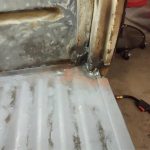
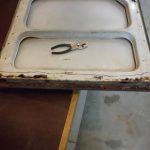
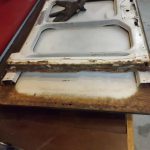
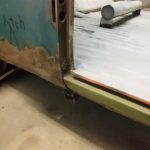
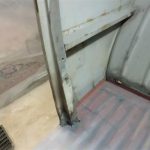
Lower Passenger Side B Pillar Repair
The bottom of the passenger side B pillar had rusted through. The rusted section was cut out, a custom piece was cut, bent, and then welded in. Also, the passenger side cargo floor repair section that I installed years ago was a generic repair piece that fit buses from the late 1950’s through 1967. Somewhere in that date range the size of the seat mounting plate shrunk. The repair piece had included the larger size plate, so I trimmed it to match the three remaining original plates.



